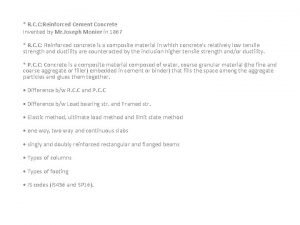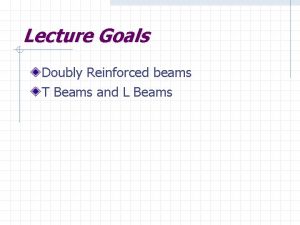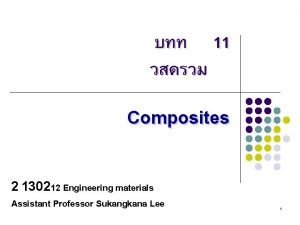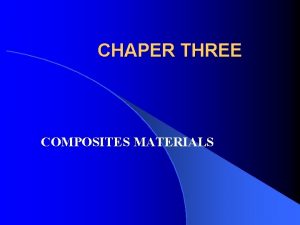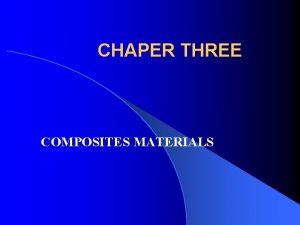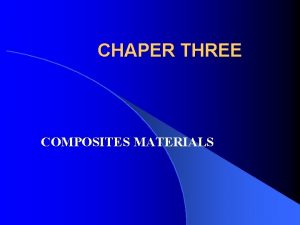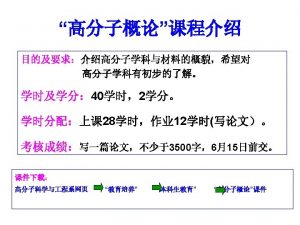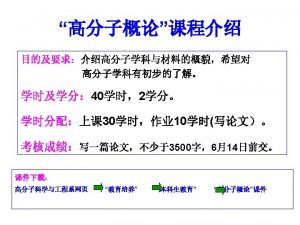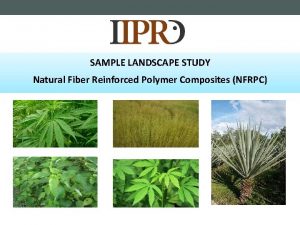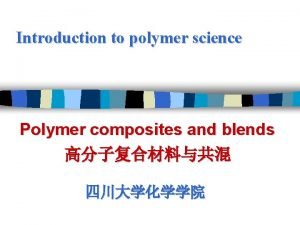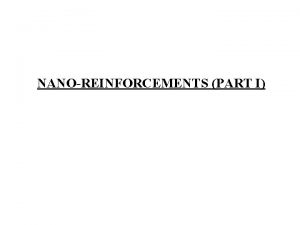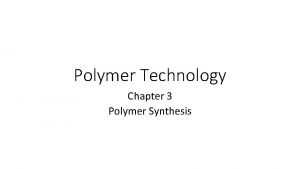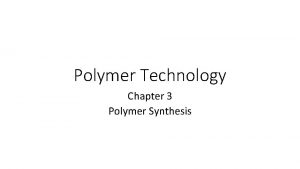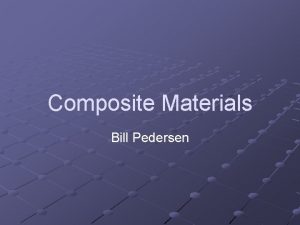CHAPER THREE COMPOSITES MATERIALS REINFORCED POLYMER l Introduction













- Slides: 13

CHAPER THREE COMPOSITES MATERIALS

REINFORCED POLYMER l Introduction l The major problem in the application of polymers in engineering is their low stiffness and strength compared to metals. l Stiffness and strength are improved by two means. l 1. Improve of design and shape. (Ribs and box sections) l 2. The addition of reinforcing particles or fibers to form a composite material.

EXAMPLE OF COMPOSITE MATERIALS l 1. Small boats (epoxy resin and continuous Kevlar and Carbon fibre). l 2. Carbon fibre reinforced nylon tennis racquet. l 3. Rubber car tire. (Carbon black, and polyester fibre and steel wires).

PRINCIPLE OF POLYMER REINFORCEMENT. l. A good reinforcing additive has the following attributes: l 1. It is stiffer and stronger than the polymer matrix. l 2. It has good particles size, shape and surface character for effective mechanical coupling to the matrix l 3. It preserves the desirable qualities of the polymer matrix l 4. Lowest net cost.

MECHANISM OF REINFORCEMENT Consider the case of a single cylindrical reinforcing particles embedded in a block of polymer matrix and perfectly bonded to it. l Figure (a) shows imagined horizontal lines drawn in the block before load is applied l Figure (b) demonstrate the strain distribution which develops under load. l Figure a Figure b

ASSUMPTIONS MADE FOR THIS MECHANISM l 1. The particle is stiffer than the material and deforms less, causing the martial strain to be reduced overall l 2. The particle achieves its restraining effect on the martial via the particle-matrix interface. l The effectiveness of reinforcement is characterized by the ratio of surface area of reinforcement to volume of the reinforcement. (A/v) l Therefore this ratio should be as high as possible.

For a cylindrical particles and lif l(aspect ratio)

A plot of A/V against a is shown in Fig. 3 l a >> 1 the reinforcement is fibre. l a << 1 the reinforcement is platelet. l Figure 3. Surface to area ratio A/V of a cylindrical particle of given volume plotted versus aspect ratio a=l/d • Examples of fibre reinforcement are glass, carbon and Kevlar • Examples of platelet reinforcement are mica and talc.

l But, the most critical parameters of reinforcement are the cost of the material and processing l The cost of the materials depends on whether the decisive factor is cost per unit mass on cost per unit volume. l Since the reinforcement additive has a different density from that of the polymer matrix. Thus the density of the composite differs from that of polymer.

l l l l Consider the fibre-reinforced polymer shown is Figure 4 The mass of the composite is m, and the volume of the composite is V. It contains a mass mf of fibers occupying a volume Vf. and a mass mm of matrix occupying a volume Vm. If we assume no voids. m = mf + mm 3. 4 a V = Vf + Vm 3. 4 b Figure 4

l By expressing the properties of fibre and matrix in the composite by the fractions of the total volume. 3. 5 l. Combine equation 3. 4 b and 3. 5 l. Dividing equation 2. 4 a by V

Example 3. 1

Thank You See You Next Lecture
 Matthews chapter 5
Matthews chapter 5 Social learning examples
Social learning examples Concrete grade c30/37
Concrete grade c30/37 Who invented rcc
Who invented rcc Design of singly reinforced beam
Design of singly reinforced beam Single and double reinforcement beam
Single and double reinforcement beam Wallboard that has been reinforced with lexan®:
Wallboard that has been reinforced with lexan®: Bragi god of poetry
Bragi god of poetry Concrete buckets osha
Concrete buckets osha Plastic centroid reinforced concrete
Plastic centroid reinforced concrete Composite structure
Composite structure Rim process
Rim process Employers must not place construction loads
Employers must not place construction loads Vci anticorrosive kraft paper with woven
Vci anticorrosive kraft paper with woven



